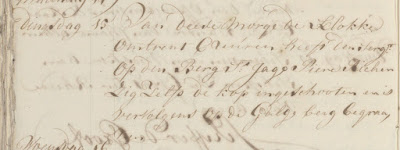In any case, before the advent of modern medicine and principals of hygiene in the latter part of the nineteenth century, mortality and morbidity were high. For any arriving European it was a matter of surviving the first year and subsequently keeping a keen eye on a style of living that was as healthy as possible. And in some cases, personal physique and genetic make-up assisted survival as well.
But this is about physical health. What about psychological health? Living in West Africa was not easy on the mind either. However, this is a subject much less studied. For the Dutch presence on the Gold Coast we have one clearly documented case, that of the Asante Prince Kwamena Poku in 1850 (Doortmont & Smit, 2007: 268). He was brought to the Netherlands in 1837, with his cousin Kwasi Boakye, who went on to become a planter in the Netherlands East Indies. Kwamena Poku, a potential heir to the Asante throne, returned to the Gold Coast where he stayed at Elmina as guest of the governor. He was shunned by his uncle, the king of Asante and dissuaded from returning to Kumase, however, and subsequently found live unbearable. After lunch on 22 February 1850 he returned to his room, took a gun, and blew his brains out.
This is a case of an African gentleman returning to his own country and experiencing a severe inverse culture shock, together with utter social abandonment by his family. For Europeans, documented examples of suicide are scarce.
The Elmina Journal for 1749 mentions a suicide by a European sergeant named as Pierre Richer:
'Tuesday 15 [April 1749] This morning around 6 o'clock, the sergeant on the Hill of St. Jago, Pierre Richer, has shot himself in the head, and was subsequently buried on Gallow's Hill.'The director-general, who wrote the journal, made short shrift of the occurrence. Suicide was a crime, and hence the hurried burial on Gallow's Hill, the burial place for convicted criminals. Nothing about the possible reasons for the suicide, the poor man's state of mind in the days and weeks before he killed himself, or anything else. It happened, he was buried, and that was the end of it.
Now, some 267 years later, Pierre Richer, just another anonymous West India Company servant, becomes the first known example of a European suicide in Elmina.
Literature:
Doortmont, Michel R. & Jinna Smit, Sources for the mutual history of Ghana and the Netherlands: An annotated guide to the Dutch archives relating to Ghana and West Africa in the Nationaal Archief, 1593-1960 (Leiden / Boston: Brill 2007), p. 268.
Sources:
National Archives of the Netherlands, Archives of the Netherlands Possessions on the Coast of Guinea (access no. 1.05.14), inv. no. 110, Elmina journal and correspondence with the outer forts, 1749, journal entry 15 April 1749 (Scan 769).
Ditto, inv. no 367, Journal 1849-1855, journal entry 22 February 1850 (Scan 45)

No comments:
Post a Comment